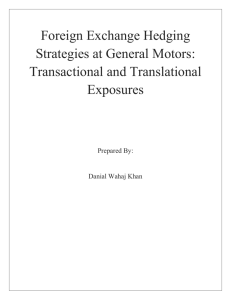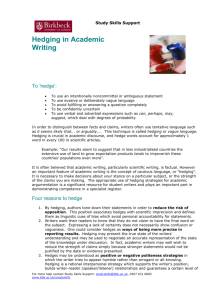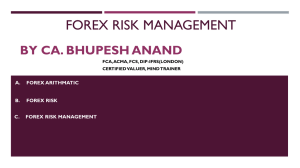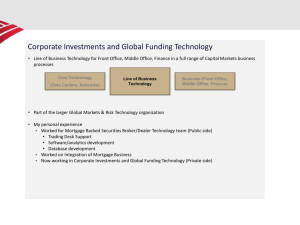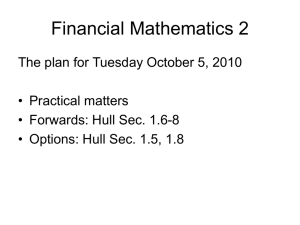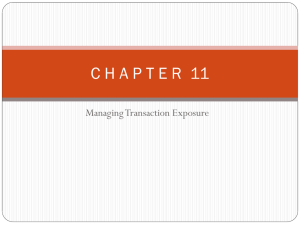MANAGING TRANSACTION EXPOSURE
advertisement
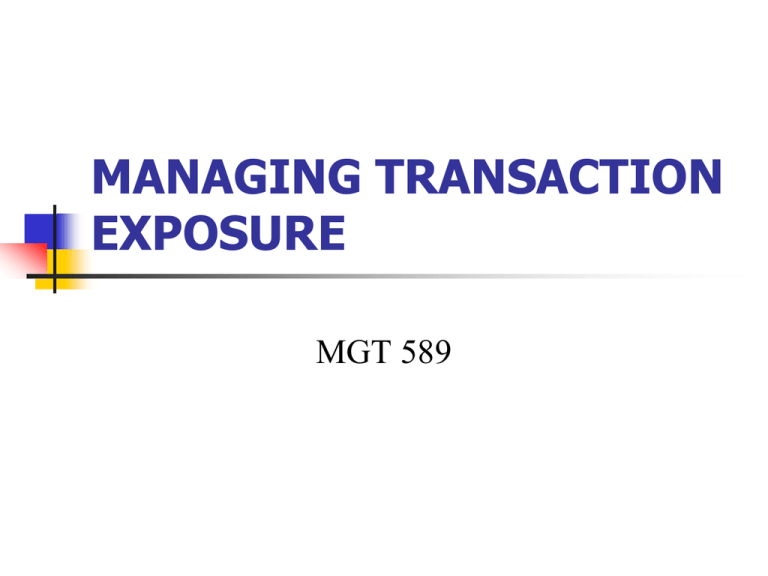
MANAGING TRANSACTION
EXPOSURE
MGT 589
Transaction Exposure
“When the future cash transactions of a
firm are affected by exchange rate
fluctuations”
identify the degree of transaction exposure
decide whether to hedge the exposure
choose technique for hedging
IDENTIFYING THE NET
TRANSACTION EXPOSURE
Netting: consolidation of all exposed inflows and outflows
for a particular time and currency.
Goal: reducing overall exposure to the MNC; maximize
the overall value of the MNC.
Subsidiary's Role:
reporting current and projected data;
assessing economic environment and trends.
Local financial markets may evaluate sub's individual financial
position and un-hedged positions may be considered more risky.
If one sub. hedges it may increase overall exposure of MNC.
If both subs hedge additional transaction costs will incur.
Examples
Eastman Kodak implements an centralized
currency management approach - instead of billing
subs in US $ it accepts local currencies.
Borg-Warner Corp. has centralized clearing house
system.
Fiat has a comprehensive monitoring and
reporting system. {421 subs in 55 countries}.
Is Hedging Worthwhile ?
Consider hedging payables with forward contracts:
If future spot rate > forward rate then gains
If future spot rate < forward rate then loses
If forward rate is an unbiased predictor of the
future spot rate then MNC will lose/gain with
equal frequency.
Yet MNC may prefer knowing its cash flows with
certainty to enhance corporate planning.
Adjusting Invoice Policy
Modifying invoicing policy to reduce
transaction exposure; e.g., invoicing in the
same currency that will be needed to pay for
imports.
Difficulties: precise matching of the
amounts and
timing of cash flows.
Summary of techniques for
hedging transaction exposure
Hedging Technique
To Hedge Payables
To hedge Receivables
1. Futures contract
Purchase futures
contract on the FC
Sell futures
Contract on the FC.
2. Forward contract
Purchase forward
contract on the FC
Sell forward contract on the FC.
3. Money Market
Hedge
* Borrow LC ($);
* convert to FC;
* invest abroad;
* payback LC loan;
* pay off supplier.
* Borrow the FC;
* convert to LC ($);
* invest at home;
* pay loan from A/R
* receive $ invested
4. Currency Option
hedge
Purchase FC call
options;
Purchase a currency
Put option.
Real cost of hedging payables
RCHp = NCHp - NCp
NCHp = nominal cost of hedging payables
NCp = nominal cost of payables without hedging
Example: Need to pay SF100,000 in 90 days. The
90-day forward SF rate is $0.62 and the spot rate
is $0.65. The firm estimates the following possible
spot rates in 90 days and assigns a subjective
probability with each possibility.
Real Cost of Hedging-example
Possible
Spot rate
Probability
Nominal costs
NCHp
NCp
Real cost
RCHp
$0.58
.10
$62,000
$58,000
$ 4,000
0.60
.20
62,000
60,000
2,000
0.62
.60
62,000
62,000
0
0.64
.10
62,000
64,000
(2,000)
Hedging cost
Expected Cost of Hedging =
.1(4000)+.2(2000)+.6(0)+.1(2000)=$600
Expected spot rate =
.1(.58)+.2(.60)+.6(.62)+.1(.64) = 0.614
Real cost of hedging
receivables
RCHr = NRr - NRHr
NRr = nominal home currency revenues
without hedging
NRHr = nominal home currency revenues
with hedging.
Note: NCH can be expressed in percentages
to facilitate comparison with hedging
positions in different currencies.
ILLUSTRATION OF
HEDGING TECHNIQUES
Spot rate of Swiss franc as of today = $0.71
Forward rate of Swiss franc as of today = $0.70 (180 days)
Current interest rates:
Borrowing Deposit
Switzerland
10%
8%
U.S.
6%
4%
A call option on SF that expires in 180-days, has an
exercise price of $0.70 and an premium of $0.02
A put option on SF that expires in 180-days, has an
exercise price of $0.70 and a premium of $0.03.
Probability distribution
SF spot rates in 180 days:
Possible spot rate $/Sf 0.66
0.68
0.70
0.72
Probability:
0.20
0.10
0.30
0.40
Hedging Payables:
ABC Corp. will need SF 400,000 in 180 days.
Forward Hedge:
Purchase SF 400,000, 180-day forward:
dollars needed in 180 days
= SF payables * forward SF rate
400,000 x 0.70 = $280,000
Money Market Hedge
Borrow $, convert to SF, invest SF, repay
$ loan in 180 days
Amount of SF to be invested =
SF 400,000/(1.04) = 384,615
Amount to be borrowed ($) =
384,615 x 0.71 = $273,077
Amount repaid in 180 days =
273,077 x 1.03 = $ 281,269
Call Option
Purchase call option on SF 400,000;
exercise price = 0.70, premium = 0.02
Possible
Spot rate
Probability
Exercise
Option ?
Total
cost/SF
Total cost
(SF 400,000)
0.66
.10
No
.66+.02 = 0.68
$272,000
0.68
.30
No
.68 + .02 = 0.70
$280,000
0.70
.40
No
.70 + .02 = 0.72
$288,000
0.72
.20
Yes
.70 + .02 = .72
$288,000
Expected nominal cost of SF 400,000? $284,000
Call Option – with interest on premium
Purchase call option on SF 400,000;
exercise price = 0.70, premium = 0.02, Ks = 10%
Future value of premium = .02 + 5%(.02) = .021
Possible
Spot rate
Probability
Exercise
Option ?
Total
cost/SF
Total cost
(SF 400,000)
0.66
.10
No
.66+.021 = 0.681
$272,400
0.68
.30
No
.68 + .021 = 0.701
$280,400
0.70
.40
No
.70 + .021 = 0.721
$288,400
0.72
.20
Yes
.70 + .021 = .721
$288,400
Expected nominal cost of SF 400,000? $284,400
Remain un-hedged
Possible probability Total cost of
Spot rate
SF 400,000
0.66
.10
$264,000
0.68
.30
$272,000
0.70
.40
$280,000
0.72
.20
$288,000
Expected nominal cost of SF 400,000 ?
= $277,000
Hedging Receivables
ABC will receive SF 200,000 in 180 days.
Forward Hedge:
Sell SF 180-days forward:
$ to be received in 180 days
= Receivables SF * forward rate
200,000 x 0.70 = $140,000
Money Market Hedge
Borrow SF, convert to $, invest $, use receivables
to pay off loan in 180 days.
Amount of SF to be borrowed =
200,000/1.05 = SF 190,076
Amount of $ received from converting=
SF 190,076 x 0.71 = $135,238
$ accumulated in 180 days =
$135,238 x 1.02 = $137,943
Put Option Hedge: purchase put option;
exercise price =0.70; premium = $0.03
Possible
Spot
Rate
Probab
-ility
Exercise
option?
$/Sf
received
Total
receipt
SF200,000
0.66
.10
Yes
.70 -.03 =0.67
$134,000
0.68
.30
Yes
.70 -.03 =0.67
$134,000
0.70
.40
No
.70 -.03 =0.67
$134,000
0.72
.20
No
.72 -.03 =0.69
$138,000
Expected nominal $ receipt from SF 200,000?
= 138,800
Including Interest on premium
Suppose cost of capital = 10%
Considering the future value of the option will
add $ 300 to the cost of hedging with put
option:
$ 0.03/SF x 5% x SF 200,000 = $300
Remain un-hedged
Possible Spot Probability
Rate
Total receipt
(SF200,000)
0.66
0.68
.10
.30
$132,000
$136,000
0.70
0.72
.40
.20
$140,000
$144,000
Expected nominal $ receipt from SF 400,000? =
$138,800
Some Observations
Hedge/no-hedge decision depends on managements risk
aversion.
If the forward rate is an unbiased predictor of the future
spot rate then real cost of hedging approaches zero over
time.
Actual real cost of hedging can be determined only after
the hedge is closed.
The forward market hedge and the money market hedge
can be compared directly.
If the interest rate parity exists the forward rate hedge will
yield the same results as the money market hedge.
Currency options will be more flexible when the amounts
to be hedged are not certain
HEDGING LONG-TERM
TRANSACTION EXPOSURE
Limitations of Repeated Short-term Hedging Over
Time
Forward rates will exhibit a (stable) premium over time
over a strong FC period.
Use of forward contracts during a strong FC period may
be preferable to a no-hedge strategy, but will still result
in subsequent increases in future prices.
Amount of FC to be hedged further into the future is
more uncertain.
Long-term Forward Contracts
Until recently long-term contracts were
seldom used.
Long-forwards now quoted for up to 5
years; can be tailor-made.
Attractive to firms with longer term fixedprice contracts.
Currency Swaps:
two firms with different long-term needs
€ Receipts
From German Sub's
operations
US
PARENT
$ Payments on $
denominated loans
$ Receipts
From US Sub's
operations
GERMAN
PARENT
€ Payments on €
denominated loans
Parallel Loans (Back-to-back)
Simultaneous loans provided by two parties
with an agreement to repay at a specified
point in future.
British parent desires to expand in the U.S.
US parent desires to expand in the U.K.
TECHNIQUES TO REDUCE
TRANSACTION EXPOSURE
Limitations of Hedging:
amounts to be hedged may not be known with
certainty
cost of hedging may be too high
hedging instruments in the FC may not be
available
barriers to foreign investing/borrowing may
exist.
Reducing Transaction
Exposure
Leading and Lagging: adjustments in the timing of
payments or disbursements to reflect expectations
about future currency movements.
Leading: accelerating payments in FC expected to
appreciate.
Lagging: stalling payments in FC expected to
depreciate.
Countries limit the length of time involved in
collection and receipt of payments.
Cross-Hedging
If financial contracts are not available in
one FC
hedge against another currency which is highly
correlated with the first.
Netting highly correlated currencies.
Currency Diversification
Denominate in a basket (cock-tail) of
currencies
If the FCs are not highly positively
correlated dollar value of inflows in FC will
be more stable



